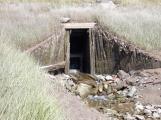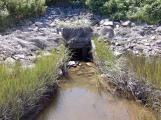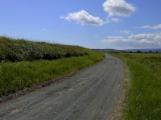14
This photo shows the Bay side of a modern aboiteau.15 September 1940
Shepody Marsh, New Brunswick, Canada

15
This photo shows the marsh side of a modern aboiteau.15 September 1940
Shepody Marsh, New Brunswick, Canada

16
The dykes visitors see today are not those built by the Acadian families. They built their dykes much closer to the bottom of the hills and not so far out on the marsh. The reason is because they did not need a large amount of dyked marsh. They only grew small crops and had few animals, so building large dykes like those we see today would have been a waste of energy. As the communities grew new dykes would be built farther out on the marsh to reclaim more land.17
This photo shows what a modern dyke looks like.15 September 2003
Shepody Marsh, New Brunswick, Canada

18
Once in place, a dyke could reclaim large tracts of very fertile land. In two or three years the salt was, for the most part, washed out of the soil and very nutritious pasture was produced for sheep and cattle. Today we see very few sheep, but cattle can still be seen in many areas, enjoying the luxurious green grasses of the salt marsh.There is a centuries old industry in the harvesting and selling of marsh hay in this area, and there is nothing so pleasant as to sit on a late summer day, watching the farm workers harvesting hay down on the marshes of Albert County or watching the cattle grazing lazily on the marsh grass.